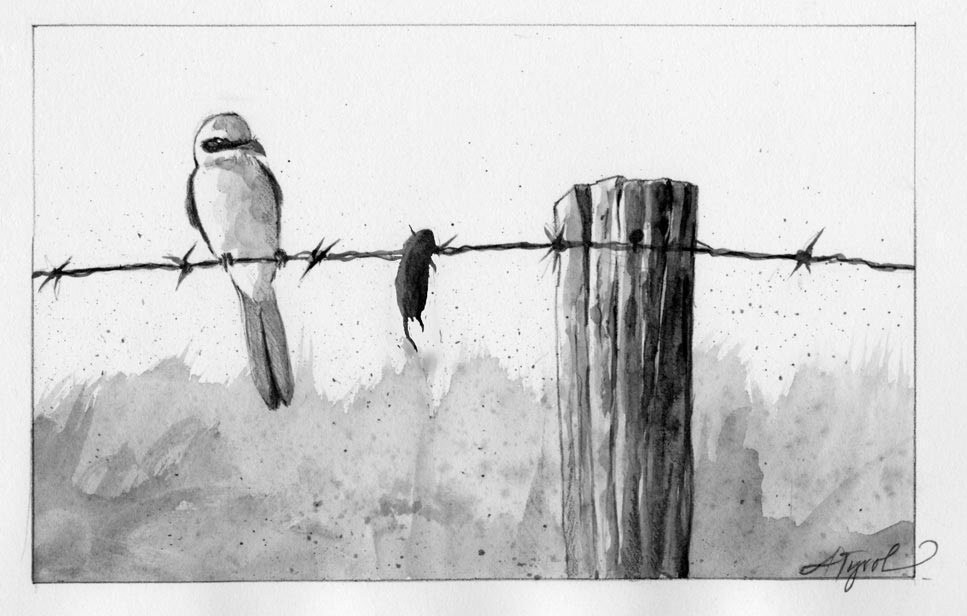
While most common songbirds migrate south for the winter, our part of the world is “south” for several birds of the far north. Snow buntings, common redpolls, and rough-legged hawks, among others, regularly move into our region in the winter months.
These northern visitors make cold-weather birding interesting, but one bird – the northern shrike – stands out because of its unusual hunting habits. The bird’s Latin name, Lanius excubitor (“watchful butcher”), gives some clue as to what comes next, but we’ll get to the gory details in a moment.
The shrike is an attractive bird, with grey on its head and back, a white chest and throat, black patches on its wings and tail, and a black mask-like band across its eyes. From a distance, you might mistake it for a blue jay.
But what makes the shrike notable is the fact that it’s a predatory songbird. Like hawks and owls, it hunts and kills for a living. But unlike most hawks and owls, the shrike is small – about the size of a robin – and unlike the raptors, it kills not with its talons, but with its sharp, notched beak.
The shrike hunts by perching atop a tall shrub or tree at the edge of a field where it surveys the surrounding area for songbirds, insects, and small mammals. From its high perch, it watches and listens for movement. When it sees or hears prey, it swoops down and uses its strong, hooked bill to dispatch its meal.
Chip Darmstadt, director of the North Branch Nature Center in Montpelier, Vermont, notes that the shrike’s bill is adapted to kill quickly and precisely. It is equipped with a tomial tooth – a small triangular projection on the beak’s upper mandible that helps shrikes surgically sever the prey animal’s spinal cord with a single well-aimed bite. The only other birds whose beaks feature a tomial tooth are falcons. This time of year you might watch a shrike swoop down from a treetop perch, land in the snow, and with a single movement of its head, grab and kill a hidden vole.
The northern shrike probably evolved this hunting technique on its far-northern breeding ground. It nests and breeds near the Arctic, on the natural edge between boreal forest and open tundra. There too, it habitually perches high atop a prominent tree or bush, scanning the tundra for prey. Its nest is a bulky cup of twigs and roots, woven together with feathers and hair. And it is so deep that when the female shrike is incubating, she is usually completely out of sight except for the tip of her long tail.
Northern shrikes migrate south in the winter to the northern U. S. and southern Canada. In some winters, they are more plentiful here than others, possibly because of fluctuations in the number of voles and small birds wintering on their home range, year-to-year.
The bird’s folk name is the “butcher bird,” and we don’t know which came first, the folk name or the butcher reference in the Latin name. But both names reflect the fact that if prey is available, the shrike will kill more than it can immediately use. It stores the extra meat, often skewering the tiny corpse so that it hangs, butcher fashion, from a thorn or a fence wire. Darmstadt has watched a northern shrike tear a mouse into chunks of meat and systematically hide them in the crotches of a small tree.
Earlier observers, noting that the shrike sometimes kills more than it immediately needs, termed the bird “bloodthirsty.” But the behavior is actually a form of caching, a precaution against times of lean hunting. The skewering serves a practical purpose, as well. A shrike’s small feet don’t allow it to properly grip large prey while it feeds, and so it impales its food to hold it in place while eating.
In all its actions, the shrike is a charismatic bird that exudes a fierce energy, even when perched watchfully atop a tree or bush at the edge of a clearing. Hunting, they often pursue smaller birds closely and intently, twisting and turning through the air like a fighter pilot.
Shrikes have what scientists call “site fidelity” – that is, they may regularly return to hunt from the same location, even the same field or treetop, winter after winter. Consequently, birders hoping to see one should regularly check out known shrike haunts and likely-looking open fields, edged by trees. Habitually scanning treetops, utility wires, and other high perches on the edge of pastures, marshes, or other wild clearings can be fruitful. Watch for a flash of white patches on gray wings as the shrike shoots across a clearing, then dramatically stalls and swoops up, landing lightly on its high perch. Once seen, the bird’s grace and power are unmistakable.


Discussion *